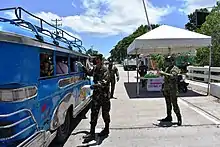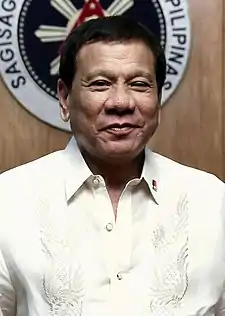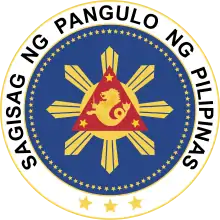COVID-19 community quarantines in the Philippines
As a measure to limit the spread of coronavirus disease 2019 (COVID-19) in the Philippines, lockdowns, officially characterized as "community quarantines" by the government, of varying strictness were imposed in numerous parts of the country. The "enhanced community quarantine" (ECQ) is the strictest of such measures. The largest of these measures was the enhanced community quarantine in Luzon.
| COVID-19 community quarantines in the Philippines | |
|---|---|
| Part of COVID-19 pandemic lockdowns | |
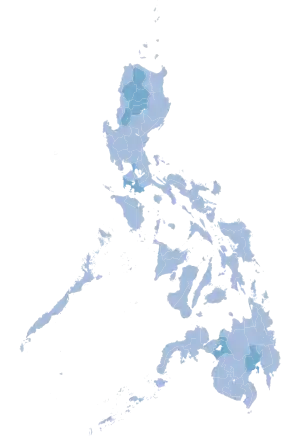 Community quarantines in the Philippines (as of February 1, 2021)
General community quarantine
Modified general community quarantine | |
| Date | March 15, 2020 – present (10 months, 3 weeks and 1 day) |
| Location | |
| Caused by | COVID-19 pandemic |
| Goals | To contain the COVID-19 pandemic in the Philippines |
| Methods | Checkpoints for checking the motivation for travel, banning of public events, closure of commercial and retail businesses, closure of schools and universities, and other prohibitions. |
Background
Given the rapidly increasing number of cases in the National Capital Region, Albay 2nd district representative Joey Salceda proposed a week-long lockdown of the region to prevent the disease from spreading nationwide. Salceda specifically proposed the closure of the Philippine expressway network and public transportation accessing the region, in addition to the suspension of classes and work.[1] President Duterte initially rejected the proposal claiming it would "hamper the flow of basic commodities".[2] Secretary Duque, however, raised the possibility of a lockdown on certain cities or towns if cases of community-based transmissions are reported, but not an entire region.[3] On March 12, President Duterte announced a partial lockdown covering Metro Manila,[4] that began on March 15.
At one point during President Rodrigo Duterte's pronouncement about the Metro Manila "community quarantine," he said that "they are afraid to call it a lockdown, but it is a lockdown."[5][6] This statement left many confused.[7] His cabinet secretary, Karlo Nograles, later made it clear that the proper term is "community quarantine" and the President's comment means that the event "is like a lockdown".[5][7] Nograles further said that the term "lockdown" can lead to different interpretations, while "community quarantine" is a technical term that medical authorities can give meaning, which does not create public fear.[7][8]
When the "community quarantine" was applied to Luzon, Presidential Spokesperson Salvador Panelo, said that the Luzon-wide enhanced community quarantine (ECQ) is equivalent to an "absolute lockdown or total lockdown."[9] Secretary Eduardo Año of the Department of Interior and Local Government (DILG) also said that "enhanced community quarantine" should be considered as a "total lockdown."[10]
In addition, President Duterte advised local government units outside of the National Capital Region to implement a community quarantine in cases where, in a given level of local government, at least two COVID-19 cases are confirmed within a lower level of its jurisdiction; for example, a province-wide quarantine should be implemented if there are at least two COVID-19 cases confirmed within different cities or municipalities in the same province, while a city/municipality-wide quarantine should be implemented if there are at least two COVID-19 cases confirmed within different barangays in the same city or municipality. Local government units were also authorized to utilize their quick response funds upon declaration of a state of emergency.[4]
The national government has given local government units under enhanced community quarantine in Visayas and Mindanao and relevant field offices of the Department of Health the power to lift or extend the lockdown period in their jurisdiction. The imposition of a "localized lockdown" involving measures at the barangay, sitio, and/or purok level instead of fully lifting ECQs has been proposed.[11]
On April 6, the following localities were under enhanced community quarantine: all regions of Luzon, Western Visayas, Caraga Region, Zamboanga Peninsula, Samar, Biliran, Cebu, Negros Oriental, Camiguin, Bukidnon, Sultan Kudarat, Lanao del Sur, Lanao del Norte, Cotabato, South Cotabato, Tawi-Tawi, and the municipality of Catarman in Northern Samar.[12]
On April 24, it was clarified that local government units can no longer impose quarantine measures without the consent of the Inter-Agency Task Force on Emerging Infectious Diseases (IATF-EID). Prior to that period, localities could impose such measures with coordination with the DILG.[13] President Rodrigo Duterte issued Executive Order 112, extending enhanced community quarantine in select localities until May 15 and imposing a general community quarantine in the rest of the country, also overriding existing quarantine measures by local government units, starting May 1.[14]
Classification
Enhanced community quarantine (ECQ)
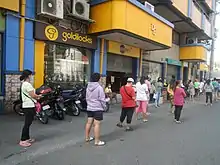
Localities under an enhanced community quarantine (ECQ) are generally ordered to stay at home, with its residents restricted from traveling to other cities or barangays. Barangay governments can issue quarantine passes allowing residents to buy essential goods outside curfew hours and within the issuing barangays' jurisdiction. The Bayanihan to Heal as One Act also provides measures related to the ECQ, such as:[15]
- Limitations on an all forms of transportation
- Work suspensions and the setting up of alternative working arrangements such as teleworking
- Ensuring the supply of food and medical products
- Measures against profiteering and hoarding of essential goods
- Provision allowing a 30-day grace period for loan and rental payments during the quarantine period
- Cancellation of mass gatherings
- Closure of non-essential businesses
- 24/7 opening of essential businesses and utilities in 100% operational capacity
General community quarantine (GCQ)
The general community quarantine (GCQ), which was introduced on May 1, is generally less stringent than ECQ. Public transportation is allowed at a reduced capacity and select businesses are allowed to operate at 50 to 100 percent of their regular capacity depending on their industry. Shopping malls are also allowed to operate, although only select stalls and stores are allowed to open.[16]
A level under GCQ, is called a modified general community quarantine (MGCQ).
Other measures
There are types of quarantine or lockdown measures aside from the ECQ and GCQ. Additional measures have been imposed under an "extensive enhanced community quarantine" or "extreme enhanced community quarantine" (EECQ). An EECQ is generally stricter than an ECQ. Prior to the imposition of the enhanced community quarantine in Luzon, a more lenient measure, which includes a stay-at-home order and a curfew, was imposed in Metro Manila and was officially called a "community quarantine".[15]
A "total lockdown" measure, distinct from an ECQ, has been considered, which would prohibit people from leaving their places of residence and mandate the closure of all public establishments. According to presidential spokesperson Harry Roque, this measure is considered as an option.[17]
A "special concern lockdown" can be applied to only a portion of a barangay with a high concentration or clustering of active cases of COVID-19. It can be a road, a compound, or a block.
A classification of measures called "new normal", a level under MGCQ, was introduced sometime in June 2020, but has not yet been used. An area needs to be placed under MGCQ prior to the imposition of new normal measures.[18]
Implementation
Prior to May 1
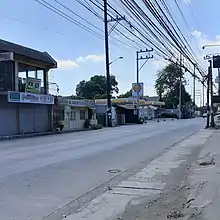
The enhanced community quarantine in Luzon covers the island of Luzon and its outlying islands, or eight out of seventeen regions of the Philippines. An indefinite enhanced community quarantine, was imposed in Caraga, alternatively known as One Shield Caraga, started on April 7,[19] and in the Davao Region[20] which took effect on April 4.[20]
Provinces that imposed an enhanced community quarantine include Iloilo (March 21),[21] Antique (March 22),[22] Negros Occidental (March 30),[23] Cebu (March 30),[24] and Negros Oriental (April 3).[25]
The independent cities of Bacolod (March 30),[23] Iloilo City (March 21),[21] and Cebu City (March 28)[24] also imposed ECQ measures.
May 1–15
Enhanced community quarantines (ECQs) were extended in Metro Manila, Central Luzon (excluding Aurora), and Calabarzon regions as well as in the provinces of Benguet, Pangasinan, Iloilo, Cebu, and the cities of Bacolod and Davao until May 15 as per President Rodrigo Duterte's Executive Order 112. All other areas were placed under general community quarantine (GCQ) unless otherwise approved by the IATF-EID.[14] Albay and Zamboanga City were also included among local government units placed under ECQ.[26] The IATF-EID allows local government units, the imposition or extension of ECQ at a municipal or barangay level with the concurrence of their respective regional IATF-EID.[27]
The municipality of San Jose remained under ECQ while the rest of Occidental Mindoro downgraded to GCQ.[28] Marinduque[29] and Bacolod also remained under ECQ.[30]
Request to extend ECQs in the following areas were rejected by the IATF-EID: the provinces of Camarines Sur, La Union, Mountain Province, Isabela, Lanao del Norte, and Lanao del Sur, and the cities of Marawi and Butuan.[27]
May 16–31
On May 12, 2020, it was originally announced that community quarantine measures will be lifted in 41 provinces and 11 cities across the country due to their being low risk for coronavirus disease 2019 (COVID-19),[31] but were eventually upgraded to modified general community quarantine (MGCQ) after receiving petitions from LGUs starting May 16.[32]
On May 15, 2020, the IATF-EID approved the appeal of Mayor Lani Mercado-Revilla placing the city of Bacoor in the province of Cavite under modified enhanced community quarantine.
The IATF-EID issued Resolution No. 37, overriding prior plans, placing Metro Manila, the cities of Angeles and Bacoor, as well as the provinces of Laguna, Bataan, Bulacan, Nueva Ecija, Pampanga, and Zambales under modified enhanced community quarantine, which is more lenient than an ECQ but stricter than a GCQ. Cebu City and Mandaue were placed under ECQ while the rest of the country was placed under GCQ. The measure became effective on May 16 with quarantine measures to be reassessed on May 31.[33]
June 1–15
The IATF-EID issued Resolution No. 41 to override prevailing quarantine measures in the country starting June 1. Measures in Metro Manila, Central Luzon and Central Visayas regions transitioned to general community quarantine (GCQ). GCQ remained in Cagayan Valley, Pangasinan (except Dagupan), Zamboanga City and Davao City, while the rest of the country was placed under modified general community quarantine (MGCQ).[34] However, Marc Brian Lim, the city mayor of Dagupan, suspended the implementation of GCQ measures in the city to MGCQ as directed by the IATF-EID. This followed Dagupan recording 14 additional COVID-19 cases on May 31, the day prior the city was supposed to transition to MGCQ. Lim appealed to the IATF-EID for the task force to allow his city to remain under GCQ.[35]
June 16–30
Due to the sudden increase number of community transmissions in the area, the IATF-EID recommended the reimposition of the enhanced community quarantine (ECQ) to Cebu City starting on June 16, the most stringent lockdown-measure tier with the neighboring Talisay being reimposed under the modified enhanced community quarantine (MECQ). Meanwhile, GCQ was extended or reimposed in the areas of Metro Manila, Cagayan Valley, Central Luzon, Calabarzon, Occidental Mindoro, the rest of Central Visayas, Zamboanga City and Davao City.[36]
July 1–15
On June 23, the IATF-EID temporarily removed the "new normal" classification which meant that all areas in the country will still be under varying levels of community quarantine after the June 16–30 measures.[37]
The GCQ were either reimposed or extended to the provinces of Benguet, Cavite, Leyte (except Tacloban), Rizal, Southern Leyte, and several parts of Cebu. Only Cebu City remained under ECQ as the city confirms more cases.[38][39]
July 16–31
On July 15, quarantine measures continued to ease as Cebu City shifted to MECQ. Metro Manila remains under GCQ for another two weeks. Other areas under GCQ includes the provinces of Agusan del Norte, Basilan, Cavite, Laguna, Rizal, and Southern Leyte, as well as the cities of Butuan, Lapu-Lapu, Mandaue, Ormoc, and Zamboanga. The rest of the country shifts to MGCQ.[40][41]
August 1–15
Quarantine measures for August 1 to 15 were decided on July 30 and was announced on July 31.[42] Cebu City's MECQ has finally been downgraded to GCQ. Other places that are still under GCQ includes: the Metro Manila, the provinces of Batangas, Bulacan, Cavite, Laguna, and Rizal, the cities of Lapu-Lapu, Mandaue, Talisay, and Zamboanga, and the municipalities of Consolacion and Minglanilla in Cebu. The rest of the country are still under MGCQ.[43]
On August 2, the IATF-EID responded to the appeal of 40 medical societies led by the Philippine College of Physicians to place Metro Manila under ECQ again due to rising COVID-19 cases.[44] The meeting later decided to place Metro Manila, Bulacan, Cavite, Laguna, and Rizal back under MECQ from August 4 to 18.[45]
August 16–31
The provinces of Batangas, Nueva Ecija, and Quezon in Luzon and Iloilo City in the Visayas were placed under GCQ again on August 16. While the cities of Cebu, Mandaue, Lapu-Lapu, and Talisay, and the municipalities of Minglanilla and Consolacion in the Cebu province remained under GCQ. Zamboanga City was placed under MGCQ.[46]
On August 17, on the recommendation of the IATF-EID, President Duterte announced that Metro Manila and its neighboring provinces of Bulacan, Cavite, Laguna, and Rizal will be downgraded to GCQ starting August 19.[47][48] His speech was broadcast from Davao City.
On August 21, Catbalogan was placed under ECQ, following Samar Governor Reynolds Michael Tan signed an executive order amid a spike of cases. [49] Tuguegarao was placed under MECQ for ten days, from August 26 to September 4.[50]
September
On August 31, President Duterte approved the recommendation of IATF-EID, to place Iligan under MECQ. The GCQ in Metro Manila, Batangas, and Bulacan was also extended, while the quarantine measures in Bacolod and Tacloban were upgraded to GCQ. The rest of the country were placed under MGCQ on September 1.[51]
Lanao del Sur and the city of Bacolod were also placed under MECQ from September 8 to 30,[52] due to the sudden rise of COVID-19 cases linked to local transmissions within these areas.[53]
The cities of Koronadal and General Santos were also placed under GCQ from September 11 to 25[54] and September 13 to 27,[55] respectively, while the province of South Cotabato was placed under GCQ from September 16 to 30.[56] Iloilo City was placed under MECQ, from September 25 to 30,[57][58] originally scheduled to end on October 9.
October
On September 28, President Duterte announced that the GCQ in Metro Manila, Bacolod, Batangas, Iloilo City, and Tacloban will be extended from October 1 to 31, while the MECQ in Iligan will be downgraded to GCQ. Lanao del Sur (including Marawi) on the other hand, will be placed under MECQ for the entirety of October. The rest of the country will remain under MGCQ.[59]
Ilagan in Isabela was placed under MECQ from October 6 to 16,[60] then to ECQ from October 16 to 30, amid rising cases in the city.[61] Enrile in Cagayan was placed under MECQ from October 6 to 16.[62] Northern Samar was placed under GCQ from October 20 until November 3.[63]
November
On October 27, President Duterte announced in his televised address from Davao City, that the GCQ in Metro Manila, Bacolod, Batangas, Iloilo City, Tacloban, and Iligan will be extended until November 30, while Lanao del Sur will be placed under GCQ. The rest of the country will remain under MGCQ.[64][65]
Davao City was also placed under GCQ from November 20 until November 30, amid sudden rise of COVID-19 cases in the city.[66] Laoag in Ilocos Norte was placed under MECQ from November 27 until December 11, due to spike in cases in the city.[67]
December
On November 30, President Duterte announced that the quarantine measures in Metro Manila, Batangas, Davao City, Iligan, Iloilo City, Lanao del Sur, and Tacloban will remain as they are until December 31. Davao del Norte was upgraded to a GCQ due to its high positivity rate, while Bacolod was downgraded to a MGCQ. The rest of the country will remain under MGCQ.[68]
Laoag was downgraded to GCQ from December 12 until December 25.[69][70] On December 14, the province of Isabela was placed under GCQ and will be under that quarantine measure until December 30.[71]
January
On December 28, President Rodrigo Duterte has announced that the GCQ in Metro Manila, Batangas, Davao del Norte, Isabela, Lanao del Sur, Davao City, Iligan, Iloilo City and Tacloban will be extended until January 31, while Santiago will be upgraded to GCQ. The rest of the country will be placed under MGCQ.[72][73]
On January 1, Isabela and Iloilo City has been downgraded to MGCQ.[74] Laoag was placed under GCQ on January 11.[75] Tuguegarao was placed under ECQ from January 20 until January 29, due to the spike of cases in the city.[76] It was extended until February 3, as the cases were still rising.[77] Passi was placed under ECQ from January 28 until February 11.[78]
February
On January 29, it was announced that the following areas will be placed under GCQ: the Cordillera Administrative Region and Metro Manila, the provinces of Batangas, Davao del Norte, and Davao del Sur, and the cities of Tacloban, Davao City, and Iligan for the whole month of February. The rest of the country will be under a more lenient MGCQ, unless otherwise stated.[79]
Statistics
| Regional quarantines[lower-alpha 1] | ||||||
|---|---|---|---|---|---|---|
| Region[lower-alpha 2] | Island group | Start date[lower-alpha 3] | Est. pop.[lower-alpha 4] | Cases | Deaths | Recov. |
| Metro Manila | Luzon | March 17, 2020 | 13,600,000 | 163,730 | 2,674 | 138,708 |
| Cordillera | 1,800,000 | 1,577 | 16 | 997 | ||
| Ilocos Region | 5,200,000 | 1,996 | 42 | 1,320 | ||
| Cagayan Valley | 3,600,000 | 1,883 | 22 | 1,191 | ||
| Central Luzon | 12,100,000 | 16,508 | 202 | 11,302 | ||
| Calabarzon | 15,700,000 | 54,048 | 588 | 41,279 | ||
| Mimaropa | 3,100,000 | 1,466 | 23 | 1,019 | ||
| Bicol Region | 6,000,000 | 2,529 | 63 | 2,014 | ||
| Western Visayas[12] | Visayas | – | 7,800,000 | 11,964 | 247 | 8,351 |
| Davao Region | Mindanao | April 2, 2020 | 5,200,000 | 3,189 | 80 | 2,545 |
| Caraga | April 7, 2020 | 2,700,000 | 1,399 | 21 | 771 | |
| Zamboanga Peninsula[12] | – | 3,800,000 | 2,280 | 91 | 1,744 | |
| Province-level quarantines | ||||||
| Province | Region | Start date | Est. pop.[lower-alpha 4] | Cases | Deaths | Recov. |
| Negros Oriental | Central Visayas | April 3, 2020 | 1,400,000 | 283 | 5 | 223 |
| Bohol[81] | March 16, 2020 | 1,400,000 | 530 | 8 | 413 | |
| Cebu[lower-alpha 5] | March 28, 2020 | 5,000,000 | 21,123 | 1,214 | 18,526 | |
| Biliran[12] | Eastern Visayas | – | 180,000 | 125 | 2 | 115 |
| Samar[82] | March 30, 2020 | 810,000 | 1,619 | 13 | 1,349 | |
| Camiguin[12] | Northern Mindanao | – | 92,000 | 29 | 0 | 27 |
| Bukidnon[83] | April 13, 2020 | 1,500,000 | 367 | 3 | 216 | |
| Lanao del Norte[lower-alpha 6][84] | March 20, 2020 | 1,000,000 | 1,258 | 31 | 902 | |
| Lanao del Sur[12] | Bangsamoro | – | 1,100,000 | 684 | 24 | 407 |
| Tawi-Tawi[85] | March 18, 2020 | 400,000 | 124 | 3 | 27 | |
| Cotabato[12] | Soccsksargen | – | 1,500,000 | 223 | 2 | 159 |
| Sultan Kudarat[12] | – | 850,000 | 128 | 4 | 100 | |
| South Cotabato[12] | – | 1,600,000 | 511 | 8 | 297 | |
| Quarantine total[lower-alpha 7] | ~95,800,000 | 311,694 | 5,504 | 253,488 | ||
| Pandemic ongoing: Infection and fatality data as of September 30, 2020.[86] | ||||||
| For notes, see the Notes section. | ||||||
Notes
- "–" denotes that no reliable or up-to-date data is currently available for that place, not that the value is zero.
- Region-wide ECQs. Provinces and independent cities outside these regions may have also been under ECQ.
- Start date of quarantine if ECQ measures were imposed throughout the region at once. The lifting of measures may vary by date and scope and measures may be re-imposed again. All quarantine measures overridden on May 1, 2020.
- Population estimate is by the Philippine Statistics Authority as of July 2019 based from projections made from the 2015 Census of Population.[80]
- including Cebu City, Mandaue, and Lapu-Lapu
- including Iligan
- Case data for the provinces listed above were not counted separately from their respective regions. These were only added for comparison purposes only.
References
- Panti, Llanesca (March 9, 2020). "Lawmaker wants weeklong NCR lockdown amid COVID-19 threat". GMA News. Retrieved March 9, 2020.
- Lopez, Virgil (March 9, 2020). "Duterte thumbs down lockdown for Metro Manila over COVID-19". GMA News. Retrieved March 9, 2020.
- "DOH: 'Localized lockdown' possible amid coronavirus pandemic". CNN Philippines. March 10, 2020. Retrieved March 10, 2020.
- Esguerra, Darryl John (March 12, 2020). "BREAKING: Metro Manila placed under 'community quarantine' due to COVID-19". Philippine Daily Inquirer. Retrieved March 12, 2020.
- Venzon, Cliff (March 13, 2020). "Duterte orders Manila lockdown from Sunday". Nikkei Asian Review. Retrieved April 1, 2020.
- Petty, Martin; Lema, Karen (March 12, 2020). "Philippine capital on lockdown to contain coronavirus". Reuters. Retrieved April 1, 2020.
- Cudis, Christine (March 13, 2020). "No lockdown, just 'community quarantine': Nograles". Philippine News Agency. Retrieved April 1, 2020.
- Cabico, Gaea Katreena (March 13, 2020). "'Is it a lockdown or a community quarantine?' Your questions about latest move vs COVID-19 answered". The Philippine Star. Retrieved April 1, 2020.
- Merez, Arianne (March 16, 2020). "Luzon under enhanced community quarantine as COVID-19 cases rise". ABS-CBN News. Retrieved April 1, 2020.
- Bajo, Anna Felicia (March 17, 2020). "Enhanced community quarantine means lockdown in Luzon, says Año". GMA News. Retrieved April 1, 2020.
- Abatayo, Rosalie (April 6, 2020). "VisMin LGUs, DoH can decide to lift or extend ECQ". Philippine Daily Inquirer. Retrieved April 7, 2020.
- "Situational Report No.8 of the National Task Force (NTF) for COVID-19" (PDF). National Disaster Risk Reduction and Management Council. April 8, 2020. Retrieved April 8, 2020.
- Chavez, Chito (April 24, 2020). "LGUs need go signal from IATF to impose lockdowns". Manila Bulletin. Retrieved May 3, 2020.
- Gita-Carlos, Ruth Abbey (May 1, 2020). "Duterte issues EO on ECQ, GCQ implementation". Philippine News Agency. Philippine News Agency. Retrieved May 3, 2020.
- Limos, Mario Alvaro (April 20, 2020). "What is ECQ, EECQ, Lockdown, and Partial Lockdown?". esquiremag.ph/life/health-and-fitness/what-is-ecq-lockdown-and-partial-lockdown-a00293-20200420-lfrm. Retrieved May 4, 2020.
- Quieta, Racquel (April 29, 2020). "GUIDE:What's the difference between ECQ and GCQ?". GMA News. Retrieved May 4, 2020.
- Gita-Carlos, Ruth Abbey (April 17, 2020). "IATF not tackling proposed 'total lockdown': Nograles". Philippine News Agency. Philippine News Agency. Retrieved May 4, 2020.
- Share; Twitter; Twitter; Twitter. "IATF-EID eyes shift to 'new normal' for areas under MGCQ: Palace". Philippine News Agency. Retrieved July 30, 2020.
- Crismundo, Mike (April 7, 2020). "Caraga region now under enhanced community quarantine". Manila Bulletin. Retrieved April 7, 2020.
- Causon, Andoreena (April 2, 2020). "Davao Region to be placed under enhanced community quarantine on Saturday". ABS-CBN News. Retrieved April 2, 2020.
- Yap, Tara (March 21, 2020). "Iloilo city, province now under enhanced community quarantine". Manila Bulletin. Retrieved April 7, 2020.
- "Antique under enhanced community quarantine". Philippine News Agency. Philippine News Agency. March 23, 2020. Retrieved April 7, 2020.
- "Stay at Home: ECQ in Negros, Bacolod starts". Daily Guardian. March 30, 2020. Retrieved April 7, 2020.
- Israel, Dale. "Cebu placed under enhanced community quarantine". Philippine Daily Inquirer. Retrieved April 1, 2020.
- "Enhanced community quarantine starts in Negros Oriental". Manila Bulletin. April 3, 2020. Retrieved April 7, 2020.
- Pareño, Roel; Mendez, Christina (May 3, 2020). "IATF OKs Albay, Zamboanga ECQ extension". The Philippine Star. Retrieved May 3, 2020.
- Fonbuena, Carmela (May 3, 2020). "Gov't task force rejects ECQ requests of several provinces". Rappler. Retrieved May 7, 2020.
- Virola, Madonna (May 1, 2020). "San Jose, Occidental Mindoro under extended ECQ". Philippine Daily Inqurer. Retrieved May 3, 2020.
- Mataac, Romeo Jr. (May 3, 2020). "ECQ sa Marinduque, pinalawig hanggang Mayo 15" [ECQ in Marinduque extended until May 15] (in Filipino). Philippine Information Agency. Retrieved June 20, 2020.
- "Negros Occidental downgrades to GCQ, Bacolod extends ECQ to May 15". Manila Bulletin. May 2, 202. Retrieved May 3, 2020.
- "Quarantine lifted in 41 provinces, 11 cities at low risk for COVID-19". GMA News. May 12, 2020. Retrieved May 12, 2020.
- "Duterte puts NCR, other 'high-risk' areas under modified ECQ". GMA News. May 12, 2020. Retrieved May 12, 2020.
- "Metro Manila, Laguna, 7 other areas shift to modified ECQ". GMA News. May 16, 2020. Retrieved May 16, 2020.
- "IATF Resolution No. 41 on GCQ, MCGQ and reclassification of barbershops and salons under Category IIi". MindaNews. IATF-EID. June 1, 2020. Retrieved June 7, 2020.
- "14 front-liners in Dagupan test positive for Covid-19". Philippine News Agency. Philippine News Agency. June 1, 2020. Retrieved June 7, 2020.
- "Cebu City under ECQ again, Talisay City on MECQ". SunStar Cebu. IATF-EID. June 16, 2020. Retrieved June 7, 2020.
- Esguerra, Darryl John (June 23, 2020). "No more 'new normal'? Philippines to keep coronavirus quarantines for now". Philippine Daily Inquirer. Retrieved July 30, 2020.
- Rey, Aika. "Duterte extends GCQ in Metro Manila until July 15". Rappler. Retrieved June 30, 2020.
- Esguerra, Darryl John (July 1, 2020). "Metro Manila stays under GCQ until July 15 – Duterte". Philippine Daily Inquirer. Retrieved June 30, 2020.
- Luna, Franco (July 15, 2020). "Metro Manila to remain under GCQ; MECQ over Cebu City". The Philippine Star. Retrieved July 15, 2020.
- "Cebu City eases to modified ECQ, Metro Manila stays under GCQ". CNN Philippines. July 15, 2020. Retrieved July 15, 2020.
- "Duterte to bare new lockdown status today". Manila Bulletin. July 30, 2020. Retrieved July 30, 2020.
- Merez, Arianne. "GCQ in Metro Manila extended until Aug. 15 even as COVID-19 cases increase". ABS-CBN News. Retrieved August 3, 2020.
- "NCR under ECQ anew nixed". Manila Bulletin. August 2, 2020. Retrieved August 3, 2020.
- "Metro Manila, 4 provinces to be placed under MECQ upon frontliners' call for tighter restrictions". cnn. Retrieved August 3, 2020.
- "Palace announced GCQ and MGCQ areas from August 16-31, 2020". The Summit Express. August 15, 2020. Retrieved August 18, 2020.
- Geducos, Argyll Cyrus (August 18, 2020). "Metro Manila, 4 neighboring provinces back under GCQ". Manila Bulletin. Retrieved August 18, 2020.
- "Metro Manila now in GCQ". PTV News. August 17, 2020. Retrieved August 18, 2020.
- Desacada, Miriam (August 22, 2020). "Catbalogan under ECQ". The Philippine Star. Retrieved September 1, 2020.
- "Tuguegarao City to revert to stricter MECQ for 10 days". cnn. Retrieved August 27, 2020.
- "Iligan City placed under stricter lockdown, Metro Manila remains under GCQ". Manila Standard. August 31, 2020.
- "IATF Resolution No. 69-A" (PDF). Official Gazette of the Republic of the Philippines. Inter-Agency Task Force on Emerging Infectious Diseases. September 7, 2020. Retrieved September 7, 2020.
- "MECQ in Lanao del Sur and Bacolod City gets IATF nod". CNN Philippines. September 7, 2020. Retrieved September 7, 2020.
- Estabillo, Allen (September 11, 2020). "Koronadal reverts to GCQ amid rising Covid-19 local transmission". Philippine News Agency. Retrieved September 29, 2020.
- Jubelag, Joseph (September 11, 2020). "GenSan seeks GCQ status to address growing number of COVID-19 cases". Manila Bulletin. Retrieved September 29, 2020.
- Sarmiento, Bong (September 16, 2020). "South Cotabato reverts to GCQ as COVID-19 cases soar". Philippine Daily Inquirer. Retrieved September 29, 2020.
- "Iloilo City placed under 15-day MECQ effective Sept. 5". CNN Philippines. September 24, 2020. Retrieved September 29, 2020.
- Lena, Perla (September 25, 2020). "Iloilo City back to MECQ classification". Philippine News Agency. Retrieved September 29, 2020.
- "Metro Manila to keep GCQ status until Oct. 31, Lanao del Sur to shift to MECQ". Retrieved September 28, 2020.
- Visaya Jr., Villamor (October 7, 2020). "MECQ imposed on Ilagan City; kids among 33 new COVID-19 patients". Philippine Daily Inquirer. Retrieved October 25, 2020.
- "Ilagan City shifts back to ECQ". ABS-CBN News. October 17, 2020. Retrieved October 25, 2020.
- Visaya Jr., Villamor (October 7, 2020). "Cagayan town placed on 14-day MECQ". Philippine Daily Inquirer. Retrieved October 25, 2020.
- Cardenas, Teresita (October 21, 2020). "Northern Samar placed under General Community Quarantine". Philippine Information Agency. Retrieved January 13, 2021.
- Valente, Catherine (October 27, 2020). "Duterte: Metro Manila stays under GCQ for another month". The Manila Times. Retrieved October 27, 2020.
- Ranada, Pia (October 27, 2020). "Metro Manila under GCQ until November 30". Rappler. Retrieved October 27, 2020.
- https://www.sunstar.com.ph/article/1877454/Manila/Local-News/Davao-City-reverts-to-GCQ-as-infections-continue-rising
- "Laoag City under MECQ beginning Friday, Nov. 27". ABS-CBN News. November 27, 2020. Retrieved December 6, 2020.
- https://cnnphilippines.com/news/2020/11/30/PH-quarantine-classifications-December.html
- Adriano, Leilanie (December 10, 2020). "Laoag City back to less restrictive GCQ starting Dec. 12". Philippine News Agency. Retrieved January 12, 2021.
- Blanco, Ma. Joreina Therese (December 24, 2020). "With decreasing COVID-19 cases, Laoag City returns to MGCQ". Philippine Information Agency. Retrieved January 12, 2020.
- "PIA Region 2". m.facebook.com. Retrieved December 14, 2020.
- Aguilar, Krissy (December 28, 2020). "Metro Manila, 9 other areas to start 2021 under GCQ". Inquirer.net. Retrieved December 30, 2020.
- "Metro Manila, 9 other areas under GCQ in January". CNN Philippines. December 28, 2020. Retrieved December 30, 2020.
- Salaverria, Leila (January 2, 2021). "Quarantine restrictions eased in Isabela, Iloilo City". Inquirer.net. Retrieved January 6, 2021.
- Mugas, John Michael (January 11, 2021). "Laoag City reverts to stricter quarantine as COVID-19 cases rise". Inquirer.net. Retrieved January 12, 2021.
- "Tuguegarao City on ECQ again". The Manila Times. January 21, 2021. Retrieved January 23, 2021.
- "Tuguegarao City stays under ECQ until Feb. 3". CNN Philippines. January 30, 2021. Retrieved February 1, 2021.
- Lena, Perla (January 28, 2021). "Iloilo's Passi City reverts to ECQ". Philippine News Agency. Retrieved February 1, 2021.
- Aguilar, Krissy (January 29, 2021). "Metro Manila, CAR, 6 other areas under GCQ in February – Palace". Philippine Daily Inquirer. Retrieved January 29, 2021.
- "Updated Population Projections based on 2015 POPCEN (xlsx file)". Philippine Statistics Authority. October 4, 2019. Retrieved May 12, 2020.
- "Over 400 caught violating ECQ in Bohol". The Bohol Chronicle. April 21, 2020. Retrieved May 13, 2020.
- Amazona, Roel (April 15, 2020). "Samar extends province-wide restrictions to fight Covid-19". Philippine News Agency. Retrieved May 12, 2020.
- Jerusalem, Jigger (April 28, 2020). "Bukidnon put under general community quarantine". Davao Today. Retrieved May 12, 2020.
The EO 21 was signed April 25 but will take effect April 27 (downgrade of Bukidnon to GCQ). The ECQ was implemented (in Bukidnon) through the issuance of EO 20 on April 13.
- Umel, Richel (March 20, 2020). "Iligan City, Lanao Norte town put on community quarantine". MindaNews. Retrieved May 12, 2020.
- "Executive Order No. 2020-05". Facebook. Tawi-Tawi Provincial Government. Retrieved May 12, 2020. – Pages 1, 2, 3
- "COVID-19 Tracker". Department of Health (Philippines). September 30, 2020. Retrieved October 1, 2020.
